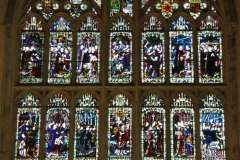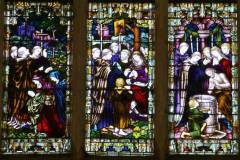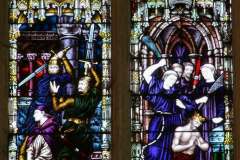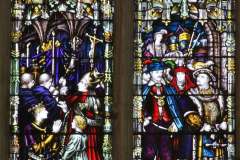This window which is above your head as you enter the Chapter House mimics the east window in that it show the same characters in the same order; the difference is that this window shows some of the events for which the people portrayed are famous. The glass in the window dates from 1903 (Image 1).
As in the east window there are 21 main lights. Starting in the top left, it shows the meeting of Queen Bertha and St Augustine; St Augustine preaching; the baptism of King Ethelbert in St Martin’s church Canterbury; St Theodore of Tarsus planning the re-organisation of the Church of England; the murder of St Alphege by the Danes in 1012; Lanfranc planning the new Norman Cathedral and monastery; St Anselm reluctantly accepting his nomination as archbishop from the sick William II lying in bed.
The second row shows: the murder of Thomas Becket; the penance of Henry II being beaten: the translation of Becket’s bones to the shrine in 1220; St Edmund Rich advising Henry III against taxing the church; the marriage of Edward I to Margaret of France in the Martyrdom in 1199; the entry of the Black Prince with the captive King John of France after the battle at Poitiers in 1357 and finally the death of Simon Sudbury at the hands of rioters during the Peasants’ Revolt in 1381.
In the bottom row there is; the funeral of Henry IV in the Trinity Chapel in 1413; Henry VIII’s visit to Canterbury in 1520 with the Emperor Charles V and Cardinal Wolsley; Archbishop Thomas Cranmer is shown being forced to listen to a sermon by the Provost of Eton before being burnt at the stake in Oxford; Archbishop William Laud about to be beheaded on Tower Hill in 1645; Archbishop John Tillotson preaching around 1690 to King William III and Queen Mary; Archbishop Benson presiding over the Third Lambeth Conference in 1888; and finally the coronation of Queen Victoria in 1838 with Archbishop William Howley giving communion.
What to see:
- In the top row, Queen Bertha, Augustine and King Ethelbert who started the cathedral in 597 (Image 2)
- In the second row, Thomas Becket and Henry II who made Canterbury Cathedral a major pilgrimage site for 370 years (Image 3)
- In the third row, two kings who were particularly important, one who is buried here and the other for what he destroyed, Thomas Becket’s shrine. Henrys IV and VIII (Image 4)
AT




